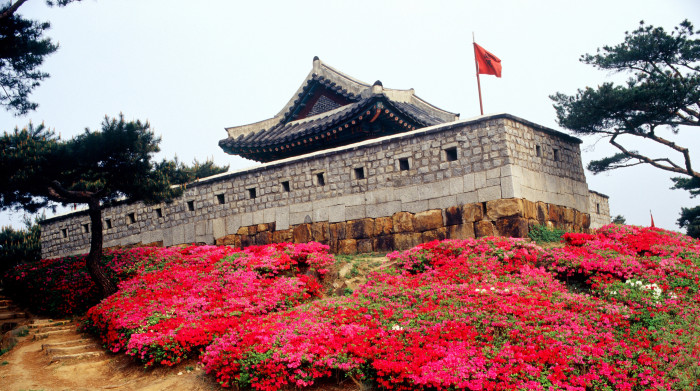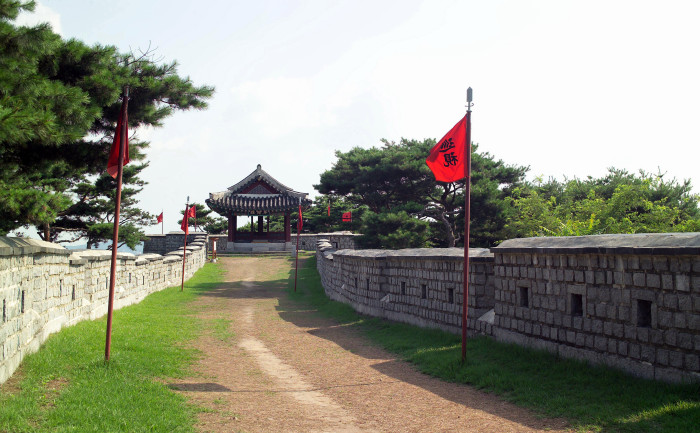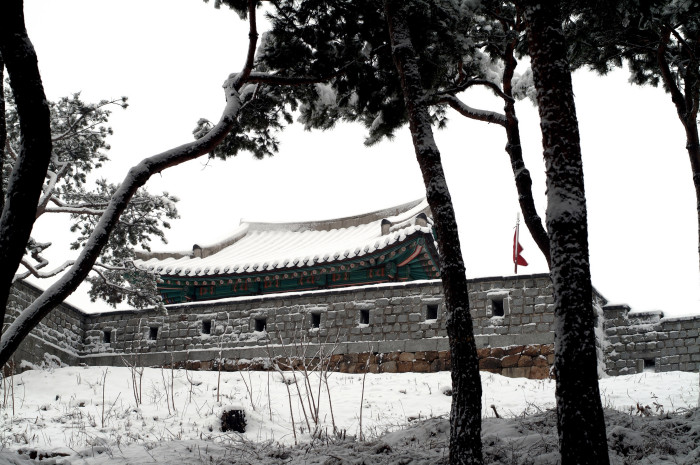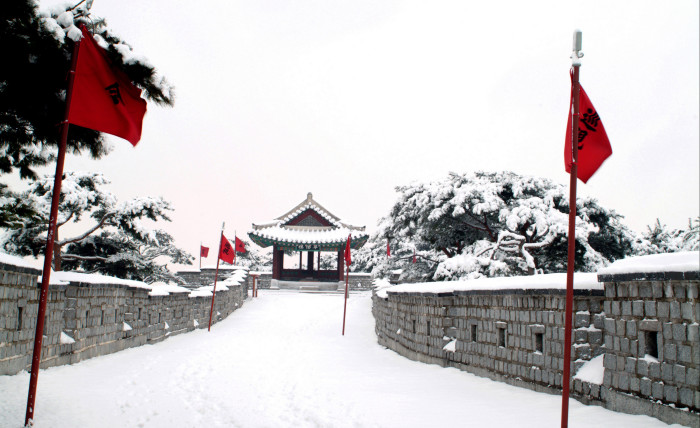경기문화재단
Suwon_Secret Attraction
A Road to Hwayangnu Pavilion
Jeong Su-ja (Poet)
When I opened the door, the Hong Kong film In the Mood for Love came to my mind. Was it because the original title of the film, Hwayang Yeonhwa (or Huayang Nianhua in Chinese) has the same word, Hwayang, with the name of this pavilion, Hwayangnu? What is certain is that the road I took to visit the pavilion was unfolded before me as if a carefully hidden jewel box opened its lid. The first impression of the pavilion was strong indeed just like that of the film when I first watched it. That is probably why the pavilion reminded me of the film.
When I first visited the pavilion in 2000, it was standing on a well-cared plot of green grass with its gate firmly locked. There was a narrow footpath made through the lawn leading to the Hwayangnu Pavilion which was soaring into the blue sky. The path and its surroundings were in complete peace and I felt I was committing a crime of breaking it when I stepped into it. Pine trees were drooping their branches over the path, emitting fragrant air. With the trees and their fragrance, the footpath leading to the pavilion created a landscape which I would never forget.
Hwayangnu is the nickname of the Southwestern Pavilion (Seonamgangnu) of the Hwaseong Fortress in Suwon. Today, the pavilion is better known by its nickname than its proper name probably because of its poetic meaning which is “flower sunshine.” The beautiful name, however, did not make it more popular than other attractions largely because it is located together with the Southwestern Barracks (Seonamposa) at a place on the southern ridge of Paldalsan Mountain which slightly higher than other ridges. The comparatively poor accessibility helped the pavilion maintain the elegance of its original structure. While it is a military facility, the pavilion is generally regarded as one of the two most beautiful architectural pieces of the Hwaseong Fortress, the other being Banghwasuryujeong (or Dongbuk Gangnu, “Northeastern Pavilion”) as both appear more like elaborately designed pavilions than military buildings.

What makes Hwayangnu more attractive than other buildings is its architectural style. The pavilion is built on the section of the fortress wall projected from the main curtain wall by about two hundred meters and designed to be concealed by the Seonamposa barracks and a postern gate. The Hwaseong Fortress is praised for various architectural merits it retains of which the layout of the curtain wall, featuring the shape of a willow leaf resulted from the effort not to disrupt the people’s homes which had already occupied the sites concerned, is particularly highly regarded together with the Hwayangnu Pavilion carefully hidden to keep it from being observed or discovered by the enemy. The pavilion also provided a wonderful vantage point overlooking the scenic landscapes outside the fortress although today much of the landscapes are covered by tall dense pine trees growing outside.
The first character “hwa (華)” in the name of Hwayangnu came from the name of the fortress Hwaseong (華城, literally meaning “floral fortress”) while the second, “yang (陽)”, has the meaning of “sunny south.” The meaning of the pavilion’s name is then slightly different from the title of the film, Hwayang Yeonhwa (花樣年華), where the second character, “yang (樣)” means “appearance”. The difference is, however, insignificant because both names are related with the beauty of flowers. There is on the ridge beam of the pavilion an inscription describing its origin and praising the outstanding achievements of King Jeongjo (r. 1776-1800) who built it. Records provide that the king, renowned for the virtue of filial piety above all else, often visited the pavilion where he could look south where the graves of his parents, originally titled Hyeollyungwon but later promoted to Yungneung, lied, and shed tears.


The construction of the Hwaseong Fortress created many popular attractions for the city of Suwon. Artists and men of letters in the past selected the “eight great views” around the walled city in spring and autumn and praised them with poetry and paintings. Today, these selected attractions have a large number of visitors every day. The Banghwasuryujeong Pavilion, which is generally regarded the best of eight great view, is particularly widely loved for the scenic beauty created by, among others, Hwahongmun Gate and Yongyeon Pond and easy accessibility. By comparison, the Hwayangnu Pavilion has fewer visitors largely because they need to walk up a comparatively remote and hilly footpath. That the postern gate providing the entrance to the path had long remained closed also contributed its relative anonymity—it was in 2013 that the gate was open at all times. Before that, the admirers of the moon rising above the pavilion had to secretively clamber over the high fortress wall at night.
The construction of the Hwaseong Fortress created many popular attractions for the city of Suwon. Artists and men of letters in the past selected the “eight great views” around the walled city in spring and autumn and praised them with poetry and paintings. Today, these selected attractions have a large number of visitors every day. The Banghwasuryujeong Pavilion, which is generally regarded the best of eight great view, is particularly widely loved for the scenic beauty created by, among others, Hwahongmun Gate and Yongyeon Pond and easy accessibility. By comparison, the Hwayangnu Pavilion has fewer visitors largely because they need to walk up a comparatively remote and hilly footpath. That the postern gate providing the entrance to the path had long remained closed also contributed its relative anonymity—it was in 2013 that the gate was open at all times. Before that, the admirers of the moon rising above the pavilion had to secretively clamber over the high fortress wall at night.


This tiny little road is particularly loved by young couples who seek after a romantic atmosphere and an attractive place where they can whisper about their days ahead. It is a short path, but the beauty of the surrounding nature intermixed with its historical significance makes it a gem of the Korean heritage preserved in this part of the country. For me personally, the footpath bridges the exquisite historical building covered with pine fragrance with my loving memory of the most powerful, also the briefest, moment of love as it was depicted in the 2000 Hong Kong film.
Finally, I have to mention the eighth great autumnal view of Hwaseong before I end this writing. Dubbed Yangnu Sangseol (陽樓賞雪, literally “watching snow fall at the sunny pavilion”), the view makes anyone’s heart beat at the expectation of the rendezvous with their loved one under the first snow of the season. I am ready myself to walk up the path to the pavilion of Hwayangnu on the first snow day in the coming winter and shoot the scene of In the Mood for Love still vivid in my memory.
<ggc의 모든 콘텐츠는 저작권법의 보호를 받습니다.>